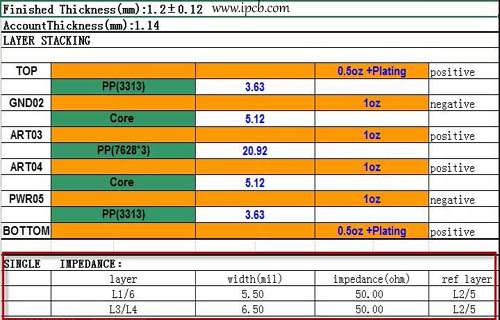Why PCB design generally controls 50ohm PCB impedance? Let iPCB give you the answer.
In the process of PCB design, before wiring, we usually stack the items we want to design and calculate the PCB impedance according to the thickness, substrate, number of layers and other information. After calculation, we can get the following figure.

50ohm PCB impedance
As can be seen from the above figure, the single-ended network designed above is generally controlled by 50ohm PCB.
Many people will ask why the control is based on 50ohm PCB instead of 25Ohm PCB or 80ohm PCB.
First of all, the default choice is 50ohm PCB, and everyone in the industry accepts this value. Generally speaking, it is certain that a recognized organization has formulated a certain standard, and we design according to the standard.
A large part of electronic technology is in the military. First of all, the technology is used in the military, and it is gradually transferred from military to civilian.
In the early days of microwave application, during the Second World War, the choice of impedance was completely dependent on the needs of users, and there was no standard value. With the development of technology, it is necessary to give the impedance standard in order to balance the economy and convenience.
In the United States, the commonly used conduit is connected by the existing scale rod and water pipe. 51.5 ohm PCB is very common, but the adapter and converter used are 50-51.5 ohm PCB. To solve these problems, an organization named Jan was established (later desc organization), which was specially developed by mil. After comprehensive consideration, 50 ohm PCB was selected, which is related to this The conduit was manufactured and converted into a standard for various cables.
At this time, the European standard was 60 ohm PCB. Soon after, under the influence of the dominant companies like Hewlett Packard in the industry, Europeans were forced to change. Therefore, 50 ohm PCB eventually became a standard in the industry, and it became a convention. In order to match the impedance, PCBs connected with various cables were also required according to the 50 ohm PCB impedance standard.
Secondly, the formulation of general standards will be based on the comprehensive consideration of PCB production process, design performance and feasibility.
From the perspective of PCB production and processing technology, considering the equipment of most existing PCB manufacturers, it is easy to produce PCB with 50 ohm PCB impedance.
It can be seen from the PCB impedance calculation process that a low impedance requires a wide linewidth and a thin medium or a large dielectric constant, which is difficult to meet in space for the current high-density PCB board. while a high impedance requires a thinner linewidth and a thicker medium or a smaller dielectric constant, which is not conducive to the suppression of EMI and crosstalk. At the same time, for multilayer PCB and from the perspective of mass production, the processing reliability is also very high It will be worse.
Control PCB 50 ohm impedance, under the environment of using common PCB board(FR4, etc.) and common core boards, to produce products with common PCB thickness (such as 1 mm, 1.2 mm, etc.), the common line width (4 ~ 10 ml) can be designed, which is very convenient for the plate factory to process, and the requirements for the processing equipment are not very high.
Considering PCB design, 50 ohm PCB is also the choice after comprehensive consideration. In terms of the performance of PCB routing, it is better to have low impedance. For a transmission line with a given line width, the closer it is to the plane, the corresponding EMI will be reduced and the crosstalk will also be reduced.
However, from the point of view of the whole signal path, we need to consider a key factor, that is, the driving ability of the chip. In the early days, most chips could not drive transmission lines with PCB impedance less than 50Ohm, while transmission lines with higher impedance were not easy to implement, so they adopted 50 ohm PCB impedance.
Therefore, 50ohm PCB is generally selected as the default value of single ended signal control PCB impedance.